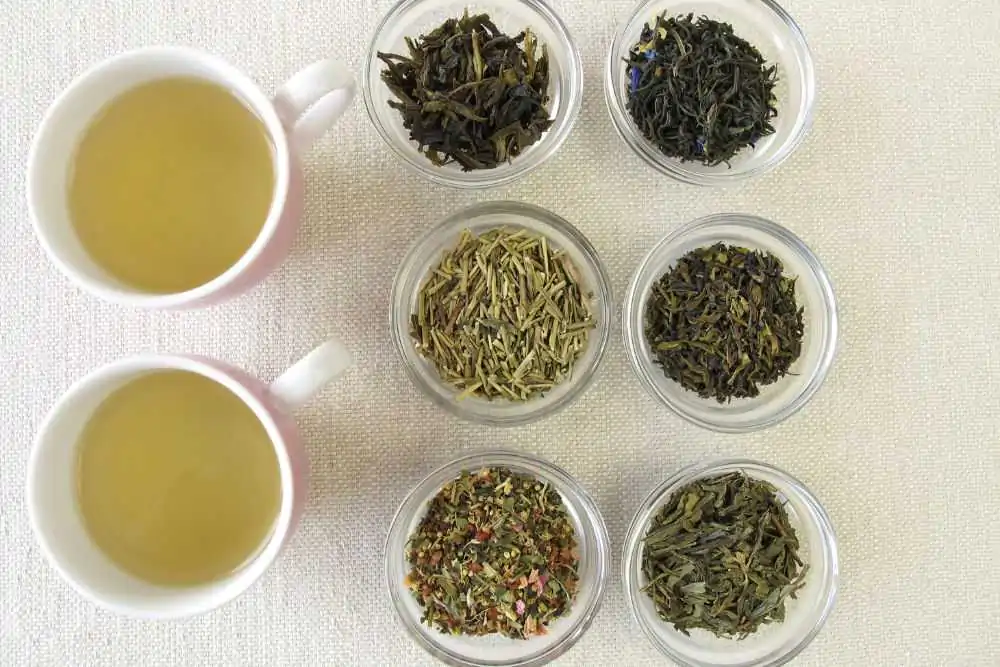If you love drinking tea, you may be interested in sampling different green tea flavors. From matcha to sencha and more unique varieties, let’s explore more.

If you’re like me, you probably drink a lot of coffee. However, recently, I started switching to tea. I mostly switched for the health benefits but also because it didn’t make me as caffeine-dependent as coffee.
Although I first started with black tea, I’ve discovered that green tea is actually much better in a lot of ways. I was also surprised to learn that there are so many green tea flavors, including matcha, sencha, gyokuro, and many more.
1. Matcha Green Tea
Matcha green tea has a long and storied history that dates back to the 8th century in China. During this period, people would dry their tea leaves and then crush them into a powder. Making tea this way offered a richer and denser flavor that you couldn’t get from whole leaves.
By the 12th century, matcha was pretty well established in China, but a Buddhist monk named Moyoan Eisai brought the beverage to Japan. In Japan, matcha became something of a way of life, as Eisai developed a practice called “the way of tea.” In this case, the preparation of the tea was as much a part of the experience as drinking it.
Everything from the growth cycle to the preparation method is by design in Japan. For example, only shade-grown leaves are used, and only the top three layers of the camellia sinensis plant are harvested. All of these standards make matcha one of the best-selling teas available, although it’s also one of the most expensive.
Matcha has a rich flavor, which is made possible by drinking the powder instead of filtering it out. It has a deep earthiness and nuttiness, with slight hints of bitterness and grass-like qualities. The overall flavor is called umami, and it’s both delicious and hard to describe.
Like most green teas, matcha is high in antioxidants and can help with liver, brain, and heart health. The purported health benefits of green tea are one of the reasons it’s so popular.
2. Jasmine Green Tea
Technically, jasmine green tea is a mixture of regular jasmine tea with green tea leaves. However, the process of mixing these ingredients dates back about 1,000 years, so it’s pretty well established.
Unlike matcha, which mostly became associated with Japanese culture, Jasmine green tea is firmly Chinese in origin. These days, if you can find tea bags of this variety, they will most likely be from China.
Jasmine green tea is steeped and filtered like regular herbal tea. For the best results, you want high-quality leaves and flowers that are both fragrant and flavorful. This flavored green tea is much more delicate and floral in its aromas and tastes.
Unlike Japanese green tea, this mixture is lighter and not as dense.
3. Sencha Green Tea
While matcha is still highly popular in Japan, the best green tea you can find in the land of the rising sun is sencha green tea. This variety didn’t arrive on the island until the 17th century, but it quickly overtook matcha as the tea of choice for many Japanese people.
A big reason why Sencha became so popular is that it didn’t require as much preparation as matcha. Instead, you can steep the leaves like other teas and then drink the liquid. Sencha comes in a few varieties, so you can choose the one you like best.
Sencha has a much more vegetal flavor to it, with notes of kale, brussels sprouts, or spinach.
4. Chai Green Tea
As with jasmine green tea, chai green tea is technically a blend of two beverage varieties. Chai tea is quite delicious and very popular around the world. Its origins date back over 5,000 years in the region we know as India.
What makes chai so tasty is that it’s a blend of different herbs and spices mixed with black tea leaves. Because you can use virtually any spices you like, there are many options to choose from when drinking chai.
Chai green tea tends to take the best of both worlds, so you wind up with a tasty and nutritious cup of green tea. However, there are only a handful of companies making this blend, so you have to do some homework to find bags of it for sale.
With so many intense ingredients competing for your tastebuds, it’s hard to pin down what chai green tea tastes like. It’s a bit fruity, spicy, sweet, tangy, and more. It’s definitely a one-of-a-kind experience.
5. Gyokuro Green Tea

Gyokuro is a variety of sencha green tea, and it’s one of the most expensive varieties of organic green tea you can find. Its origins date back to 1835 when a tea merchant named Yamamoto Kahei discovered a unique method for brewing sencha.
While it took him a while to unlock the secret, the basic premise is that the tea leaves are first covered by straw to help block the sun. Kahei also rolled his leaves into balls because the curing process made the leaves sticky, but that didn’t seem to affect the flavor.
Because of how Gyokuro is made, it has a much richer and bolder flavor than regular sencha. It’s still very grassy and leafy, but it finishes with a strong sweetness.
This tea has a high concentration of catechins, a flavonoid that aids in blood circulation and heart health. Gyokuro also contains polyphenols, which can help protect the enamel of your teeth.
6. Mint Green Tea
Technically, we could call this variety Moroccan mint tea since its origins were in Morocco in the 17th century. During the Crimean War, green tea spread throughout Morocco and the surrounding area, where locals started sweetening it with mint. Because of the intense flavors, Moroccan mint tea became a staple of the local culture.
First, you get the mild and earthy tones of green tea, followed by a light and delicate taste of mint and fruity flavors. Mint leaves can help with digestion which makes it a popular after-dinner brew. For more, check out our green tea vs. peppermint tea guide.
7. Green Rooibos Tea
Unlike other green tea varieties we’ve discussed, green rooibos tea is relatively new. Usually, this tea is red, but if you don’t ferment the leaves, they stay green, hence the color of this beverage. In this regard, it’s not technically a green tea because traditional green teas, and other true teas, come from the Camellia Sinensis plant.
Rooibos is harvested from the Aspalathus linearis, which is native to South Africa. This tea is lighter and more delicate than its red cousin and has many floral and grassy notes.
8. Kabusecha Green Tea
If you took regular sencha green tea leaves and covered them for 20 days, you would wind up with Gyokuro green tea. However, if you remove the covering after seven to 10 days, you will get kabusecha.
The way Kabusecha is grown and cultivated makes it a cross between sencha and Gyokuro tea varieties. Kabusecha is not quite as sweet or smooth as Gyokuro, but it’s still arguably better than Sencha. The preferred brewing method is to steep the leaves in hot water for longer to extract more flavor.
9. Tencha
The leaves intended for making matcha tea are shielded from the sun to boost the chlorophyll content, giving matcha its famous bright green hue. The leaves are then ground into powder. Tencha leaves are simply leaves that have not been powdered.
Tencha’s taste is often described as elegant. It’s mildly sweet.
10. Genmaicha

Genmaicha is especailly unique. It combines green tea with rice and is often nicknamed popcorn tea. The roasted brown rice makes this tea more satisfying than the average brew while still maintaining the classic green tea taste.
Since it can be tricky to track down outside Japan, you can make your own version of this green tea. All you need to do is fry some brown rice and add it to a tea strainer with Sencha tea, and brew as normal.
11. Hōjicha
Most green teas are steamed, but Hōjicha is different in this regard. The tea is roasted at a high temperature over charcoal in a porcelain pot. The roasting process eliminates any bitterness, leaving behind a smokey but sweet taste.
You might also be interested in our green tea vs. yerba mate guide.

